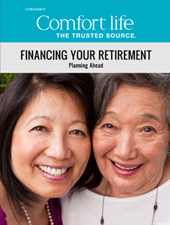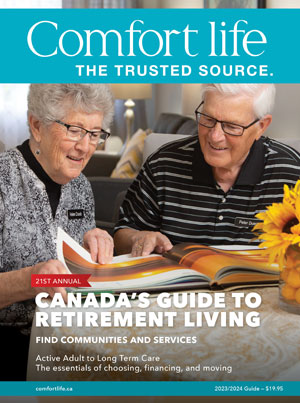What to know about this topic:
- Basic Government Pensions
- Workplace Pension Plans
- Investments
- Insurance products
- Continuing income and personal savings
- Tax Breaks for Seniors
- How you will pay for the cost of a retirement home
- How much is enough for retirement?
Thanks to today’s booming real estate market, many Canadian seniors find themselves sitting on more equity than they ever dreamed of. It used to be a hard fact of life that not everyone can afford retirement living in a high quality retirement community where friendly, helpful staff take care of every need, you eat chef-prepared meals, and live with happy peers with every day filled with “so many things to do.” Now, that lifestyle is accessible to a very broad segment of the senior population.
We think that every Canadian family owes it to themselves to investigate senior living, regardless of the economic climate. There have always been a wide variety of means Canadians have used to pay for this care and lifestyle. This begins with pension money from Old Age Security (OAS) and the Canada Pension Plan (CPP) and extends to personal finances, which can include everything from personal investments to paying out of pocket and getting personal help from kids.
Potential challenges inherent in paying for senior care are twofold:
- Planning for the care you'll need. Ideally, you want to be prepared for the worst case, for example, if you are going to need memory care while you wait for long term care.
- Having planned well enough for retirement. In a worst case scenario, seniors may have very little or no savings and no funds at their disposal other than government pensions. Ideally, you want to have income and assets that exceed retirement needs and/or care costs—and leave some funds to give to others.
This basic guide is intended to help people meet those challenges. Of course, we urge that you get advice from financial experts on all these matters. However, this guide's lengthy list of resources and ideas create a handy checklist for Canadian families who want to make sure they have checked all their p's and q's when it comes to financing a retirement home lifestyle.

Basic Government Pensions
There are two fundamental benefits used by seniors across Canada, the Canada Pension Plan (CPP) and Old Age Security (OAS). These basic income can help any senior pay their retirement home costs.
Old Age Security (OAS) benefits begin when you turn 65. (Those aged 75 and over will see an automatic 10% increase of their Old Age Security pension, as of July 2022.)
There are three additional supplements to the OAS, so you may not be restricted to just the benefits from this program. Additions and supplements to the OAS include the following:
- The Guaranteed Income Supplement (GIS) provides a monthly non-taxable benefit to Old Age Security (OAS) pension recipients who qualify; this is eligible for those with a low income who are living in Canada.
- The Allowance is an additional benefit, over and above the OAS; this is available to the spouses or common-law partners of Guaranteed Income Supplement recipients
- Allowance for the Survivor is a benefit available to people with a low income, living in Canada, and whose spouse or common-law partner is deceased. You can apply for this if you meet a variety of criteria. You can learn more about this from the Government of Canada website.
Canada Pension Plan Benefits (CPP): You can apply for and receive a full CPP retirement pension at age 65 or receive it as early as age 60 with a reduction, or as late as age 70 with an increase. This is a monthly benefit for all who have contributed to this over the course of their working lives. In addition, there is the CPP Post-Retirement Benefit, payable to those who have paid CPP while receiving CPP benefits. Other variant and supplemental benefits include the CPP Disability Pension and the CPP Survivor's Pension. If you qualify for any (or all) of these, as they say, every little bit helps.
Get more information right from the source, in the government's full look at CPP.
Workplace Pension Plans
Workplace pension plans are privately administered by employers who choose to offer them, and many people benefit from these. If you're one of the fortunate beneficiaries of a good company or government pension, paying for excellent senior living is not likely to be an issue. If not, there are still more sources of money you can tap into.
Read professional advice: "Three steps to understanding your pension options."
Investments
Home equity, savings and other funds can be invested, so that payouts can actually be used to cover costs, rather than cutting into your savings monthly. Of course, there are risks involved in investing in funds, the stock market, etc., but as long as the market is good to you, investment is better than drawing down on your nest egg. The following overview is informational only. Be sure to consult with a reputable financial advisor.
Dividend stocks are a risky investment. Dividends for stocks found on the stock market are paid out quarterly or annually. These are unreliable depending on the general confidence in the stock market and the individual performance of any company in which you invest. That said, there are some reliable stocks on the market. A high quality company will pay around four or five percent in yield per year, and this can give your investment portfolio a good boost.
Mutual funds are managed funds that target a diversity of investments and are often low risk. You pay management fees and average returns are often modest, although you can find funds that succeed.
Index funds are a kind of mutual fund that tracks a market index, typically made up of stocks or bonds. These can be more stalwart and reliable than average mutual funds, often targeting a cross-section of companies that have historically performed well.
Bonds are safer than some other investments and may appeal to more cautious investors. There's much less chance of losing your savings should the market go bust. However, these rely on interest rates, and when interest rates are low (as they have been the last few years), this does not play into investors' favour.
Guaranteed Investment Certificates (GICs) are (as the name suggests) a protected investment, guaranteed by the Canadian Deposit Insurance Corporation. Thus, as they say, it's impossible to lose money with a GIC. However, these pay bank interest rates (again, low these days). That said, these do pay a slightly higher interest rate than you'll get from a savings account.
Insurance products
An annuity is an insurance product that can offer seniors periodic payments (usually monthly), based on their original investment, current interest rates and the terms of the contract. Non-registered annuities can be taxed at favourable rates. A straight life annuity will provide income for the duration of a lifetime. A joint life annuity will provide income for life, for both spouses.
Essentially, this is an insurance policy against "living too long." Like life insurance, this sometimes works to the benefit of the insured – if they live a lot longer than expected. Talk to your insurance company to see if they offer annuities. There are several types of annuities, and not all are ideal for retirees. Immediate annuities should be "approached with caution." Other types of annuities include single-premium, flexible, deferred, fixed and variable1.
Long-term care insurance will provide tax-free benefits if you develop a critical and chronic illness and are unable to care for yourself. It may cover health and personal care services if you are living at home, in a retirement residence or a long-term care facility. Different policies will reimburse for eligible expenses, a set amount for expenses on a given day or provide flexible income without the need of proving expenses. In the past, Stephen Gadsden has provided a cautionary tale demonstrating the value of long term care insurance.
Segregated funds are insurance protected investments with guaranteed capital of either 75 or 100 per cent at maturity or death. These funds allow you to designate a beneficiary in your policy, bypassing probate fees. These have come in and out of vogue over the last 20 years, and may be most ideal if you own your own business. These have the advantage of guaranteeing the principal, but they also have higher fees for management costs2.
Selling a life insurance policy is a practice also known as life settlement, recommended as a possible option by some experts but considered dubious by others and legal only in Ontario and three other provinces. This will negatively affect the financial future of heirs and is considered a desperation move by most experts, perhaps after you have
Continuing income and personal savings
Many people continue to work during their retirement, some out of need, others out of choice. Many studies show that it is very healthy to work – at least part time – in your retirement, in order to keep active, to keep on felling valuable to society and others around you, and to keep making money. Why not, if you can find work you like? For example, retired teachers find value in staying available for supply work. Others may find a job doing something simple, even working in retail or work of that nature.
Personal savings can include equity on your home (especially helpful if you have downsized), Registered Retirement Savings Plans (RRSPs), savings accounts, investments.
Renting your primary home is a way to generate monthly income to pay for accommodations in a retirement residence. However, being a landlord also carries the demands and pressures of seeking and maintaining good tenants, while bearing the responsibility for upkeep and major repairs of the property.
Scrutinize your personal taxes to ensure you are taking advantage of all the tax exemptions and credits for which you qualify. Consider these points when consulting a tax expert:
- Residents of retirement communities or long-term care facilities can claim the cost of attendant care.
- Individuals with long-term disabilities that affect their ability to perform the functions of everyday life may qualify for a disability tax credit. This tax credit may also be transferred to a spouse.
Take a fuller look below.
Tax Breaks for Seniors
In addition to the above, Canadian senior citizens are also eligible for a number of tax credits.
Here's a brief overview of what you can claim:
The Age Amount
For anyone with a net income less than $90,313 (in 2021), the federal government allows you to claim the Age Amount on line 301 of your tax return. Get all the details on this straight from the source.
Also note that you can transfer all or part of this Age Amount to a spouse or common-law partner, or conversely you can claim all or part of your spouse's or partner's Age Amount. The CRA offers more about amounts transferred from your spouse or common-law partner.
Pension Income Amount
If you collect from a public pension plan such as the Canadian Pension Plan (or any private company pension plan: see above), you can claim a credit for this Pension Income Amount, if you have any eligible sources of pension income. Other eligible sources of income are various. These include
- annuity income you receive as payments for a pension
- annuities received as part of a superannuation plan
- payments you received from an RRSP
You can shift money between partners or spouses in order to maximize the credit you receive. You can transfer income from one spouse to another, based on who earns a higher amount. Transfer the amount to the spouse with the lowest income (and thus the lower tax rate) to decrease the overall tax you will pay. The CRA allows you to switch up to 50% of your pension income from one spouse to another in order to optimize the tax credit you receive.
Medical expenses
If your medical expenses exceed 3% of your total income, and they are not reimbursed in anyway, you can claim medical expenses as a tax credit. You can claim a wide variety of medical expenses, in fact, some of them less obvious than others. As a number of sources note, the list is actually extensive. It includes oddities like:
- Costs related to the purchase of non-gluten foods
- Costs of blood coagulation monitors
- Expenses related to service animals for those with diabetes
- Air filters or air purifiers
The full list of claimable medical expenses will surprise many. Check out the CRA's sortable list for many more eligible medical expenses: cra-arc.gc.ca/medical/. When claiming any of those, you need to be sure that you can verify those with receipts, so be sure to keep records of all expenses.
Disability tax credit
Seniors who are qualified as disabled may receive the disability tax credit. Some eligible disabilities may surprise some. Included in the list are some impairments related to activities of daily living (ADLs), typically associated with seniors in assisted living facilities; these ADL-related disabilities include feeding, dressing, and incontinence, as well as impairment of mental functions (including those requiring memory care) .
Learn more about the disability tax credit.
More federal credits
There are even more federal credits available, depending on your individual situation. Other tax credits include but are not limited to the following tax credits:
For seniors who are renovating a home, whether it's their family home or an active lifestyle home they have purchased, there is a Home Accessibility Tax Credit (HATC). This is available for anyone who is 65 or older and has made changes that improve their home's accessibility.
You can claim expenses for the following common accessibility improvements, and more:
- wheelchair ramps inside and outside of the home
- the addition of walk-in tubs
- widening of doors
- non-slip bathroom flooring
- motion-sensor lights
- much more
Learn all the details from the government, about The Home Accessibility Tax Credit. Provincial home renovation credits and/or property tax grants are also available to seniors in BC, Ontario and New Brunswick.4
How you will pay for the cost of a retirement home
According to the latest stats, a woman retiring today at 65 can expect to live another 19 years on average, while a 65-year-old man has an average of 14.9 years ahead of him. As we move into our 80s, the likelihood increases that we will need the services offered by a retirement residence or a long-term care facility.
RBC Insurance says people 65 and older account for 50 per cent of hospital days and almost 100 per cent of long-term care days. Manulife Financial points out that one in five Canadians who live in a nursing home stay for longer than five years.
A retirement home can seem expensive but the many services, activities, and the lifestyle you live there enhance the quality of your life. In point of fact, though,many people find out that they can afford senior care or housing comfortably. Even high quality retirement homes with "luxurious" amenities like hair salons and other modern conveniences are within the means of many Canadians. Costs here can exceed $5,000 per month, up to over $7,000, especially if you need care. Even in these cases, though, people are surprised at what they can afford when they look at their finances and actually consider what they are currently paying in terms of all their household costs, including groceries, gas, utilities, property taxes, etc.
One typical scenario is that an individual or a couple will receive about $2,000 from OAS and CPP. A company pension might add up to $850 per month. You may also have an RRSP or other investments that might bring in an extra $500 per month. The above figures would give you $3350 per month in relatively reliable income.
If you choose to sell your home, you will have the equity. In 2021, the Canadian national average price for home sales was $748,450. Invest that money to get a conservative return of 2.5% per year and you will end up with an extra $1560 per month. Add all those income figures above (and note: money invested notwithstanding), and this comes to $4,910 per month.
The cost of staying at home for a typical elderly couple (adjusting figures from our report on this for inflation) will be about $2750. Average rent for a suite in a retirement home (with at least one meal per day) in 2022 begin as low as $2,815, plus an additional $800 companion fee, in Ontario; this totals a monthly one-cost-to-catch-them-all of $3,615.
Worst case. In one of the worst case scenarios, you (or your family) may have to pay for memory care, at a cost of $5500 per month or higher. If you fit into the average, here's how it all stacks up:
Income
OAS: 1100
CPP: 900
Professional pension: $850
Investments: $500
Additional investment: $900
Total/month: $4250
The average wait time for a long term care home is about 6 months to a year, in which case family may be well-advised to dip into the savings or home equity to cover the costs of memory care. After a year that takes about 12,000 out of the savings or equity from the home.
After this time, you go into long term care, where the government covers care costs, and all that family is required to pay for is room and board.
How much is enough for retirement?
In the past, financial advisers used 70% of pre-retirement income as their rule of thumb for how much money we need to live in retirement, to live as well as we did when we were working. But these days, financial advisers and planners are taking a more sophisticated view of retirement.
The best advice suggests that people look at retirement as a three-stage process; each stage has different financial requirements. The first stage of retirement covers 65 to 75 years of age; at this stage, people are generally active and healthy and get to live some of their dreams. In the second stage people stay closer to home; at this stage, one spouse or both may experience declining health and require some home health care. In the final stage, one or both partners may require the help of 24-hour nursing care provided by long-term care facilities.
One final important consideration is "life planning." No one can really decide how much money they will need in retirement until they are sure what kind of retirement they really want. If you plan to sell your big house in the city and find a quiet country home where you can indulge your passion for art or gardening, your retirement needs are going to be very different from those of someone who can spend four months skiing in British Columbia and the rest of the year enjoying life somewhere in the south.
1Read more at https://www.canada.ca/en/financial-consumer-agency/services/retirement-planning/annuities.html
2Read more at theglobeandmail.com/../segregated-funds-may-be-on-the-rise-again/article24706328/ and getsmarteraboutmoney.ca/../Segregated-funds-explained
3These amounts are, see cra-arc.gc.ca/../lns300-350/301/menu-eng.html. For the Federal Worksheet: cra-arc.gc.ca/../t1gnrl/menu-eng.html
4See cra-arc.gc.ca/../5010-pc-15e.html




